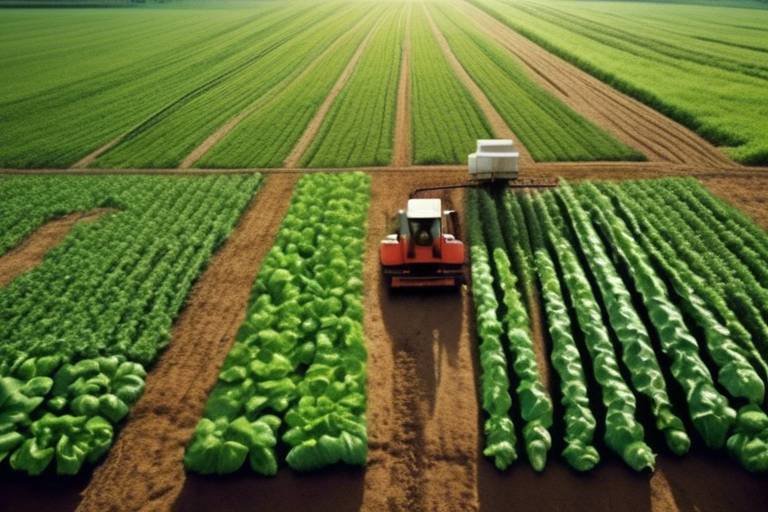How Mushrooms Can Help Solve Environmental Problems
Mushrooms are not just a delicious addition to your favorite dishes; they are also powerful allies in the fight against environmental degradation. As we grapple with increasing pollution, waste accumulation, and declining soil health, mushrooms offer innovative solutions that can help us restore balance to our ecosystems. From breaking down organic waste to cleaning up contaminated sites, these remarkable fungi play a crucial role in promoting sustainability. In this article, we will explore the various ways mushrooms contribute to environmental health, showcasing their importance in combating ecological challenges.
One of the most significant contributions of mushrooms to our environment lies in their ability to decompose organic waste. Think of mushrooms as nature's recyclers; they efficiently break down dead plant and animal matter, recycling vital nutrients back into the soil. Their extensive mycelium networks act like a natural composting system, reducing landfill waste and promoting healthier soil. When organic materials decompose, they release essential nutrients, which can nourish plants and support diverse ecosystems. This natural process not only helps in waste management but also enhances soil fertility, allowing for healthier crops and greener landscapes.
Mycoremediation is a fascinating field that involves using mushrooms to detoxify polluted environments. Certain fungi have the incredible ability to absorb heavy metals and break down harmful chemicals, offering a natural solution for soil and water contamination. Imagine a world where mushrooms can help clean up toxic waste sites, transforming them into thriving habitats. This is not just a dream; it is a reality that researchers are exploring. The potential of mycoremediation is vast, and it could be a game-changer in environmental cleanup efforts.
To truly appreciate the power of mycoremediation, we need to dive into the science behind it. Mushrooms possess unique biochemical processes that allow them to interact with contaminants. For instance, some fungi can produce enzymes that break down complex pollutants into harmless byproducts. This ability to metabolize toxins is what makes fungi such effective agents of change in polluted environments. By understanding these mechanisms, scientists can harness the power of mushrooms to develop targeted remediation strategies that are both effective and environmentally friendly.
There have been several successful case studies that illustrate the effectiveness of mycoremediation in restoring contaminated sites. For example:
| Location | Contaminant | Mushroom Species Used | Results |
|---|---|---|---|
| New York, USA | Petroleum Hydrocarbons | Oyster Mushroom (Pleurotus ostreatus) | Reduced contamination levels by 90% |
| Japan | Heavy Metals | Shiitake Mushroom (Lentinula edodes) | Significant reduction in lead and cadmium concentrations |
These examples not only demonstrate the practical applications of fungi in environmental cleanup efforts but also highlight the potential for broader implementation in various contexts.
Despite the promising potential of mycoremediation, several challenges hinder its widespread adoption. Issues such as scalability, public awareness, and regulatory hurdles pose significant obstacles. For instance, while small-scale projects have shown success, scaling these efforts to larger contaminated areas remains a challenge. Additionally, many people are unaware of the benefits of fungi in environmental remediation, which can limit support for such initiatives. Addressing these challenges requires collaboration among scientists, policymakers, and the public to create a more conducive environment for fungal solutions.
Mushrooms also play a vital role in enhancing soil health through their symbiotic relationships with plants. Mycorrhizal fungi, in particular, form partnerships with plant roots, improving nutrient uptake and promoting overall plant growth. This relationship is akin to a team effort where both parties benefit: fungi receive carbohydrates from plants, while plants gain access to essential nutrients like phosphorus and nitrogen. As a result, healthier plants lead to more resilient ecosystems, capable of withstanding environmental stressors.
In the realm of agriculture, certain mushroom species can serve as natural pest deterrents, reducing the reliance on chemical pesticides. This not only helps maintain ecological balance but also promotes sustainable farming practices. By introducing beneficial fungi into agricultural systems, farmers can enhance crop resilience against pests and diseases, leading to healthier harvests and reduced chemical inputs.
Specific fungi have been identified as valuable allies in agricultural practices. For example, Trichoderma species are known for their ability to combat soil-borne pathogens, while other fungi can enhance plant growth and improve soil structure. By incorporating these beneficial fungi into farming systems, we can promote sustainable agriculture that supports both productivity and environmental health.
The potential for mushrooms to address environmental issues continues to grow. Ongoing research is exploring innovative ways to utilize fungi in various applications, from waste management to bioremediation. As we uncover more about the capabilities of mushrooms, the future looks bright for fungal solutions in sustainability efforts. Imagine a world where mushrooms are not just a food source but also a cornerstone of ecological restoration and environmental health.
- What is mycoremediation? Mycoremediation is the use of fungi to detoxify polluted environments.
- How do mushrooms help with waste decomposition? Mushrooms break down organic materials, recycling nutrients back into the soil.
- Can mushrooms be used in agriculture? Yes, certain fungi can enhance plant growth and act as natural pest control.
- What challenges does mycoremediation face? Challenges include scalability, public awareness, and regulatory hurdles.

Mushrooms and Waste Decomposition
Mushrooms are not just delicious additions to our meals; they are also powerful allies in the fight against waste. These remarkable fungi play a crucial role in waste decomposition, acting as nature's recyclers. Their underground networks, known as mycelium, are incredibly efficient at breaking down organic materials, transforming what would otherwise be waste into valuable nutrients that nourish the soil. Imagine a bustling city where every piece of garbage is swiftly converted back into rich, fertile ground. That's the magic of mushrooms at work!
When organic matter, such as fallen leaves, dead plants, or even food scraps, enters the ecosystem, mushrooms step in to do their part. They break down these materials through a process called decomposition. This process not only reduces the volume of waste that ends up in landfills but also recycles essential nutrients back into the environment. Without mushrooms, our planet would be buried under heaps of organic waste, and the soil would suffer from nutrient depletion.
One of the most fascinating aspects of mushrooms is their ability to decompose a wide variety of substances. Here are some key points about their decomposition capabilities:
- Versatility: Mushrooms can break down complex organic compounds that many other organisms struggle with, including lignin found in wood and cellulose in plant matter.
- Speed: The decomposition process facilitated by mushrooms is often much quicker than that of traditional composting methods, making them a vital component in natural waste management.
- Nutrient Cycling: By breaking down organic waste, mushrooms help release nutrients like nitrogen, phosphorus, and potassium back into the soil, which are essential for plant growth.
Furthermore, the process of waste decomposition by mushrooms can lead to healthier soil ecosystems. As mushrooms decompose organic matter, they create a rich habitat for various microorganisms that contribute to soil fertility. This symbiotic relationship not only boosts soil health but also enhances the ability of plants to absorb nutrients, leading to more robust growth. In essence, mushrooms act as the unsung heroes of our ecosystems, ensuring that waste is transformed into a resource rather than a burden.
In urban settings, where waste management is a pressing issue, the integration of mushrooms into composting systems can significantly improve efficiency. By incorporating mushroom cultivation into waste management practices, cities can reduce landfill waste while simultaneously producing high-quality compost enriched with fungal mycelium. This compost can then be used in parks, gardens, and agricultural fields, creating a sustainable cycle of waste reduction and nutrient replenishment.
In conclusion, mushrooms are essential players in the process of waste decomposition. They not only help reduce landfill waste but also contribute to the health of our soils and the overall sustainability of our ecosystems. As we continue to explore innovative ways to manage waste and enhance environmental health, the role of mushrooms will undoubtedly become increasingly important.
Q: How do mushrooms decompose waste?
A: Mushrooms decompose waste through their mycelium networks, which break down organic matter into simpler compounds, recycling nutrients back into the ecosystem.
Q: Can mushrooms help reduce landfill waste?
A: Yes! By breaking down organic waste efficiently, mushrooms can significantly reduce the amount of waste that ends up in landfills.
Q: What types of waste can mushrooms decompose?
A: Mushrooms can decompose a variety of organic materials, including plant matter, food scraps, and even some types of wood.
Q: How can I use mushrooms in my composting?
A: You can incorporate mushroom spores into your compost pile to enhance the decomposition process and produce nutrient-rich compost for your garden.

Mycoremediation: Cleaning Contaminated Environments
Mushrooms are not just delicious additions to our meals; they are also powerful allies in the battle against environmental pollution. Mycoremediation is a fascinating process that harnesses the natural abilities of fungi to detoxify contaminated environments. Imagine a world where mushrooms can absorb heavy metals, break down harmful chemicals, and restore ecosystems that have been damaged by industrial waste. This isn't science fiction—it's happening right now, and it's changing the way we think about cleaning up our planet.
At the core of mycoremediation is the mushroom's mycelium, a vast network of thread-like structures that spread through the soil. This mycelial network acts like a sponge, soaking up toxins and transforming them into harmless substances. For instance, certain species of fungi have been shown to effectively break down petroleum products, making them invaluable in cleaning up oil spills. The ability of fungi to metabolize these pollutants is not just a happy accident; it’s a result of millions of years of evolution that has equipped them with unique biochemical pathways.
To illustrate the effectiveness of mycoremediation, consider the following table that outlines some common contaminants and the fungi that can remediate them:
| Contaminant | Fungal Species | Remediation Method |
|---|---|---|
| Heavy Metals | Phanerochaete chrysosporium | Absorption and bioaccumulation |
| Petroleum Hydrocarbons | Trametes versicolor | Biodegradation |
| Chlorinated Solvents | Ganoderma lucidum | Dechlorination |
These fungi not only cleanse the environment but also help restore the natural balance of the ecosystem. By breaking down harmful substances, they enable other organisms to thrive, creating a healthier habitat for plants and animals alike. However, while the potential of mycoremediation is immense, it is essential to understand the scientific principles behind it. The biochemical processes involved are complex and require further research to unlock their full potential.
Moreover, successful mycoremediation projects have already been documented in various locations around the globe. For example, in the aftermath of the Exxon Valdez oil spill in Alaska, researchers utilized fungi to help break down the residual oil, demonstrating the practical applications of mycoremediation in real-world scenarios. These case studies not only highlight the effectiveness of fungi in cleaning contaminated sites but also pave the way for future innovations in environmental restoration.
Nonetheless, it is worth mentioning that mycoremediation is not without its challenges. Factors such as scalability, public awareness, and regulatory hurdles can impede the widespread adoption of these natural solutions. Addressing these challenges is crucial for the future of mycoremediation and its role in sustainable environmental practices.
In conclusion, mycoremediation offers a promising avenue for cleaning up our polluted environments. By tapping into the remarkable capabilities of fungi, we can not only address immediate contamination issues but also promote long-term ecological health. As we continue to explore the depths of this fascinating field, the potential for mushrooms to transform our approach to environmental cleanup is as exciting as it is necessary.
- What is mycoremediation? Mycoremediation is the use of fungi to detoxify polluted environments by breaking down contaminants.
- How do mushrooms clean the environment? Mushrooms absorb and metabolize toxins through their mycelial networks, converting harmful substances into non-toxic forms.
- Can all mushrooms be used for mycoremediation? No, not all mushrooms have the same capabilities. Specific species are more effective at breaking down particular contaminants.
- What are the benefits of using mycoremediation? It is a natural, sustainable method of cleaning up pollution that can restore ecosystems and promote biodiversity.

The Science Behind Mycoremediation
Mycoremediation is a fascinating process that showcases the incredible power of fungi in detoxifying polluted environments. At the heart of this method lies the mycelium, a vast network of fungal threads that permeate the soil and interact with various contaminants. But how exactly do these organisms work their magic? Let’s dive into the science behind mycoremediation and uncover the biochemical processes that enable mushrooms to tackle environmental pollutants.
First and foremost, fungi possess unique enzymes that allow them to break down complex organic compounds. These enzymes can degrade a wide range of pollutants, including heavy metals and petroleum hydrocarbons. When mycelium comes into contact with these harmful substances, it secretes enzymes that transform them into less toxic forms. This transformation is not only crucial for detoxification but also aids in nutrient cycling within the ecosystem.
Moreover, certain fungi have the ability to bioaccumulate heavy metals. This means they can absorb and concentrate these toxic elements within their tissues. For instance, species like Pleurotus ostreatus (oyster mushroom) and Ganoderma lucidum (reishi mushroom) have shown remarkable capabilities in absorbing metals like lead, cadmium, and arsenic. This characteristic makes them invaluable in cleaning up contaminated sites, as they can effectively remove these hazardous substances from the environment.
To illustrate the effectiveness of mycoremediation, consider the following table that outlines some key contaminants and the corresponding fungal species known for their remediation capabilities:
| Contaminant | Fungal Species | Remediation Mechanism |
|---|---|---|
| Lead | Pleurotus ostreatus | Bioaccumulation |
| Petroleum Hydrocarbons | Phanerochaete chrysosporium | Enzymatic degradation |
| Arsenic | Ganoderma lucidum | Bioaccumulation |
Additionally, mycoremediation is not just limited to soil. Fungi can also play a significant role in purifying water. When mycelium grows in aquatic environments, it can filter out pollutants and improve water quality. This capability is particularly beneficial for restoring contaminated waterways, making fungi an essential ally in the fight against pollution.
However, understanding the mechanisms of mycoremediation is just the beginning. Researchers are constantly exploring how to enhance these natural processes through various means, such as genetic engineering and optimizing growth conditions. The potential applications are vast, ranging from large-scale environmental cleanup to innovative agricultural practices that harness the power of fungi for sustainable farming.
In conclusion, the science behind mycoremediation reveals a world of possibilities where fungi not only serve as decomposers but also as powerful agents of change in our ecosystems. As we continue to uncover the secrets of these remarkable organisms, the future looks promising for using mushrooms to combat pollution and restore our planet’s health.
- What is mycoremediation? Mycoremediation is the use of fungi to detoxify polluted environments by breaking down harmful substances.
- How do fungi break down pollutants? Fungi secrete enzymes that degrade complex organic compounds and can absorb heavy metals through their mycelium.
- Can mycoremediation be applied to water contamination? Yes, fungi can purify water by filtering out pollutants and improving water quality.
- What are some examples of fungi used in mycoremediation? Species like Pleurotus ostreatus and Ganoderma lucidum are known for their effectiveness in absorbing heavy metals and degrading hydrocarbons.

Case Studies of Successful Mycoremediation
Mycoremediation has emerged as a groundbreaking approach to environmental cleanup, leveraging the natural abilities of fungi to transform contaminated sites into thriving ecosystems. One of the most notable case studies took place in the Gulf Coast of the United States, where researchers utilized the native mushroom species, Pleurotus ostreatus, commonly known as the oyster mushroom, to address oil spills. These mushrooms were introduced to the contaminated soil, where they effectively broke down hydrocarbons, significantly reducing the toxic levels within just a few weeks. The results were astounding, demonstrating the potential of fungi to restore ecological balance in areas devastated by industrial accidents.
Another fascinating example comes from a site in New York City, where a team of scientists tackled heavy metal contamination in urban soils. They introduced a mixture of mycorrhizal fungi, which formed symbiotic relationships with local plant species. This collaboration not only enhanced the plants' ability to absorb nutrients but also facilitated the uptake of heavy metals, effectively removing them from the soil. Over the course of a year, the levels of lead and cadmium were reduced by over 60%, showcasing the promising applications of mycoremediation in urban environments.
In a more extensive project, a former industrial site in Canada was transformed using a combination of fungi and phytoremediation strategies. Here, researchers planted a variety of fungi alongside sunflowers, which are known for their ability to extract heavy metals from the soil. The fungi helped break down the contaminants, while the sunflowers absorbed the pollutants. This dual approach resulted in a remarkable cleanup, making the site safe for future development and restoring biodiversity.
These case studies not only highlight the effectiveness of mycoremediation but also illustrate the versatility of fungi in various environments. The integration of fungi into traditional cleanup methods is revolutionizing how we approach environmental restoration. However, it's essential to recognize that while these successes are promising, they also come with challenges. Factors such as the specific types of contaminants, environmental conditions, and the fungi used must be carefully considered to ensure optimal results.
As we look towards the future, the potential for mycoremediation to play a crucial role in environmental sustainability cannot be overstated. Researchers are continually exploring new fungal species and their unique properties, aiming to develop more efficient and effective mycoremediation strategies. The journey of harnessing the power of mushrooms for ecological restoration is just beginning, and the possibilities are as vast as the mycelial networks themselves.
- What is mycoremediation? - Mycoremediation is the process of using fungi to remove or neutralize contaminants from the environment, particularly in soil and water.
- How do mushrooms help in environmental cleanup? - Mushrooms can break down organic pollutants, absorb heavy metals, and improve soil health, making them effective agents for environmental restoration.
- Are there any risks associated with mycoremediation? - While generally safe, the effectiveness of mycoremediation can vary based on the type of contaminants and environmental conditions, and thorough studies are necessary to assess potential risks.
- Can mycoremediation be used in urban areas? - Yes! Mycoremediation has been successfully implemented in urban environments to tackle soil contamination and improve local ecosystems.

Challenges in Mycoremediation Implementation
While the potential of mycoremediation is indeed promising, several challenges hinder its widespread implementation. First and foremost, there is the issue of scalability. Mycoremediation techniques often work effectively in small, controlled environments, but scaling these methods to larger, more contaminated sites poses significant logistical and technical hurdles. The complexity of the contamination and the diverse environments can make it difficult to predict how mushrooms will interact with different pollutants.
Moreover, there is a general lack of public awareness regarding the benefits and mechanisms of mycoremediation. Many people are still unaware of how fungi can play a crucial role in environmental cleanup. This lack of understanding can lead to skepticism and resistance to adopting fungal solutions in favor of traditional methods, such as chemical remediation. Education and outreach are essential to changing public perception and encouraging acceptance of these natural strategies.
Another significant challenge is navigating the regulatory landscape. Environmental regulations often favor established remediation technologies, which can create barriers for innovative approaches like mycoremediation. Gaining approval for new methods can be a lengthy and complex process, requiring extensive research and documentation to prove efficacy and safety. This adds to the time and cost of implementing mycoremediation projects.
Lastly, the availability of resources and funding can limit the development of mycoremediation initiatives. Research and field trials require investment, and without sufficient financial backing, many promising projects may never come to fruition. Collaboration between governments, private sectors, and environmental organizations is crucial to securing the necessary funding and resources to advance mycoremediation practices.
In summary, while mycoremediation holds great potential for addressing environmental contamination, overcoming these challenges is essential for its successful implementation. Increased awareness, supportive regulations, and adequate funding can pave the way for a future where fungi play a vital role in restoring our ecosystems.
- What is mycoremediation? Mycoremediation is the process of using fungi to decompose and detoxify environmental pollutants.
- How effective is mycoremediation? The effectiveness can vary depending on the type of fungi used and the nature of the contaminants.
- Are there any risks associated with mycoremediation? While generally safe, the use of fungi must be carefully monitored to ensure they do not introduce new contaminants.
- Can mycoremediation be used in urban areas? Yes, mycoremediation techniques can be adapted for use in urban settings to address localized pollution issues.

Enhancing Soil Health with Fungi
Mushrooms, often overlooked in discussions about agriculture and ecology, play a vital role in enhancing soil health. At the heart of this relationship is a fascinating partnership between mushrooms and plants, primarily through a network of mycorrhizal fungi. These fungi form symbiotic associations with plant roots, creating a mutually beneficial relationship that can be likened to a well-oiled machine, where both parties thrive on each other's strengths.
Mycorrhizal fungi extend the reach of plant roots, allowing them to access nutrients and water that would otherwise be out of reach. Imagine a tiny plant trying to stretch its roots across a vast desert; it would struggle to survive. However, with the help of mycorrhizal fungi acting as a bridge, the plant can tap into a rich supply of essential nutrients, such as nitrogen and phosphorus, which are crucial for growth. In return, the fungi receive carbohydrates produced by the plant through photosynthesis, creating a beautiful cycle of life.
Research has shown that soils enriched with mycorrhizal fungi are not only more fertile but also more resilient. These fungi enhance soil structure, improving aeration and water retention. This is particularly important in times of drought when plants need every drop of moisture they can get. Furthermore, healthy soil teems with microbial life, which is essential for breaking down organic matter, recycling nutrients, and fostering a vibrant ecosystem. Without these tiny powerhouses, our soils would be lifeless and barren.
In addition to nutrient uptake, mycorrhizal fungi also play a role in disease resistance. By colonizing the root systems of plants, these fungi can help protect against pathogens and harmful nematodes. This natural defense mechanism reduces the need for chemical fertilizers and pesticides, promoting a more sustainable approach to agriculture. In essence, fungi act as silent guardians, ensuring that plants remain healthy and robust.
To illustrate the impact of fungi on soil health, consider the following table that summarizes key benefits:
| Benefit | Description |
|---|---|
| Nutrient Uptake | Enhances the absorption of essential nutrients like nitrogen and phosphorus. |
| Soil Structure | Improves soil aeration and water retention, leading to healthier plants. |
| Disease Resistance | Provides a natural defense against soil-borne pathogens and pests. |
| Organic Matter Decomposition | Helps break down organic materials, recycling nutrients back into the soil. |
In conclusion, the role of fungi in enhancing soil health cannot be overstated. They are not just decomposers; they are vital contributors to the sustainability of our agricultural systems. As we continue to explore the potential of mushrooms and their mycelial networks, we open the door to more resilient ecosystems and healthier crops. The future of farming might very well depend on these incredible organisms that work tirelessly beneath our feet.
- What are mycorrhizal fungi? Mycorrhizal fungi are fungi that form symbiotic relationships with plant roots, helping them absorb nutrients and water.
- How do fungi improve soil health? Fungi enhance soil health by improving nutrient uptake, soil structure, and disease resistance, while also aiding in the decomposition of organic matter.
- Can fungi reduce the need for chemical fertilizers? Yes, by promoting natural nutrient uptake and disease resistance, mycorrhizal fungi can reduce the reliance on chemical fertilizers and pesticides.

Mushrooms as Natural Pest Control
Mushrooms, often celebrated for their culinary delights and health benefits, also play a remarkable role in the world of agriculture, particularly in pest control. Imagine a garden thriving not just because of the sunlight and water, but also thanks to a hidden army of fungi working tirelessly beneath the surface. This is the reality of how certain mushroom species can act as natural pest deterrents, significantly reducing the reliance on chemical pesticides. By harnessing the power of these fungi, farmers can maintain a healthier ecological balance while promoting sustainable practices.
One of the most fascinating aspects of mushrooms as pest control agents is their ability to produce natural compounds that repel harmful insects. For instance, the Entomopathogenic fungi—a category of fungi that specifically targets insects—can be a game-changer in organic farming. These fungi infect and kill pests, effectively acting as a biological control mechanism. This not only helps in managing pest populations but also minimizes the environmental impact associated with synthetic pesticides.
Moreover, the use of fungi in pest management is not just limited to direct pest control. They also participate in creating a more resilient ecosystem. When mushrooms form symbiotic relationships with plants, they enhance the plants' health and vigor, making them less susceptible to pest infestations. This relationship is often referred to as mycorrhizal association, where fungi connect with plant roots and improve nutrient uptake. Healthier plants are better equipped to fend off pests, creating a natural defense system.
To illustrate the effectiveness of mushrooms in pest control, let’s take a look at some specific examples:
| Mushroom Species | Pest Targeted | Method of Action |
|---|---|---|
| Beauveria bassiana | Various insects (e.g., aphids, whiteflies) | Infects and kills pests through spores |
| Metarhizium anisopliae | Termites, beetles | Causes disease in insects, leading to death |
| Trichoderma spp. | Root rot pathogens | Competes with harmful fungi and promotes plant health |
These examples showcase how mushrooms not only target specific pests but also enhance the overall health of plants, creating a win-win situation for farmers. With the growing concerns over pesticide resistance and the ecological impact of chemical controls, the shift towards natural pest control methods is more crucial than ever.
However, while the potential is immense, it's essential to recognize the need for further research and development in this field. Understanding the specific interactions between various fungi and pests can lead to more effective applications in agriculture. As we continue to explore the capabilities of mushrooms, we may uncover even more innovative solutions to combat pest issues sustainably.
- How do mushrooms control pests? Mushrooms release spores that infect and kill specific pests, acting as a natural pesticide.
- Are mushroom-based pest control methods safe? Yes, they are generally considered safe for the environment and non-target species, unlike many synthetic pesticides.
- Can I use mushrooms in my home garden? Absolutely! There are various mushroom species that can be beneficial for home gardens, enhancing plant health and controlling pests.

Beneficial Fungi in Agriculture
When you think about agriculture, your mind might jump to crops, soil, and perhaps even the occasional tractor. But have you ever considered the silent heroes lurking beneath the surface? Mushrooms and their fungal relatives play a pivotal role in agriculture that often goes unnoticed. These fungi are not just decomposers; they are vital allies in promoting sustainable farming practices. By forming symbiotic relationships with plants, they enhance nutrient uptake and provide a natural defense against pests and diseases.
One of the most fascinating aspects of fungi in agriculture is their ability to form mycorrhizal associations with plant roots. This relationship is akin to a partnership where both parties benefit immensely. The fungi extend their hyphae—thin, thread-like structures—into the soil, which increases the root surface area of the plants. This means that plants can absorb more water and essential nutrients like phosphorus and nitrogen, which are crucial for their growth. In return, the plants supply the fungi with carbohydrates produced through photosynthesis, creating a win-win situation.
But that's not all! Certain fungi can also act as natural pest deterrents. For instance, the Trichoderma species is known for its ability to combat soil-borne pathogens. By outcompeting harmful microbes for resources, it helps maintain a healthy soil ecosystem. Additionally, fungi like Beauveria bassiana can infect and kill various insect pests, reducing the reliance on chemical pesticides. Imagine a farm where nature does the heavy lifting, ensuring crops grow strong and healthy without the toxic chemicals that can harm the environment!
Moreover, beneficial fungi contribute to soil health in ways that go beyond nutrient uptake and pest control. They help in the formation of soil aggregates, which improves soil structure and aeration. Well-structured soil not only supports plant growth but also enhances water retention, making crops more resilient to drought conditions. This is particularly important in the face of climate change, where extreme weather events are becoming more common.
| Fungal Species | Benefits |
|---|---|
| Mycorrhizal Fungi | Enhances nutrient uptake and water absorption |
| Trichoderma | Suppresses soil-borne pathogens |
| Beauveria bassiana | Natural pest control agent |
| Rhizopus | Improves soil structure and aeration |
As we look to the future of agriculture, the role of beneficial fungi is set to expand. Researchers are continually discovering new applications for these fungi, including their potential in biopesticides and biofertilizers. By integrating fungi into agricultural practices, farmers can not only enhance crop yields but also contribute to a more sustainable and eco-friendly food system.
In conclusion, the inclusion of beneficial fungi in agriculture is not just a trend but a necessity. As we strive to meet the growing demands for food while minimizing environmental impact, these fungi offer a natural solution that could revolutionize farming. They remind us that sometimes, the best solutions lie in the most unexpected places—right under our feet!
- What are mycorrhizal fungi?
Mycorrhizal fungi form symbiotic relationships with plant roots, enhancing nutrient and water absorption. - How do fungi help in pest control?
Certain fungi can outcompete or infect pest organisms, reducing the need for chemical pesticides. - Can fungi improve soil health?
Yes, fungi contribute to soil aggregation, improving structure, aeration, and water retention. - Are there any risks associated with using fungi in agriculture?
While beneficial, it's important to ensure that the fungi used are non-pathogenic and suitable for the specific agricultural context.

Future Prospects for Fungal Solutions
As we look toward the future, the potential for fungal solutions to tackle pressing environmental issues is not just exciting—it's essential. With climate change, pollution, and biodiversity loss becoming increasingly critical challenges, the role of mushrooms and fungi in sustainable practices is gaining momentum. Researchers and environmentalists are now focusing on how these remarkable organisms can be harnessed to create a healthier planet.
One of the most promising areas is the development of biotechnological applications that utilize fungi for various environmental benefits. Imagine a world where mycelium can be used not only for bioremediation but also for producing biodegradable materials, thus reducing plastic pollution. Companies are already experimenting with mycelium-based products, from packaging to construction materials, that could revolutionize how we think about waste and sustainability.
Moreover, the integration of fungi in agriculture is set to expand. As farmers seek alternatives to chemical pesticides and fertilizers, the use of beneficial fungi could lead to healthier crops and ecosystems. Mycorrhizal fungi, for instance, form symbiotic relationships with plant roots, enhancing nutrient uptake and improving soil structure. This not only boosts crop yields but also promotes soil health, creating a win-win situation for both farmers and the environment.
In addition to agriculture, the field of urban ecology is ripe for fungal innovation. Urban areas often struggle with pollution and waste management. By implementing fungi into urban landscaping and green infrastructure, cities could enhance their resilience against environmental stresses. Fungi can help break down organic waste in composting systems, reduce stormwater runoff, and improve air quality. The integration of fungal solutions into urban planning can lead to more sustainable and livable cities.
However, for these prospects to become a reality, there are challenges to address. Public awareness and education about the benefits of fungi are crucial. Many people still perceive mushrooms as mere food or a nuisance, rather than powerful allies in environmental conservation. Increasing awareness through community programs, workshops, and educational campaigns can help shift perceptions and encourage more people to embrace fungal solutions.
Furthermore, research funding is essential to explore the full potential of fungi in various applications. By investing in scientific studies, we can better understand the mechanisms by which fungi operate and develop innovative strategies for their use in environmental restoration and sustainability. Collaboration between scientists, policymakers, and the private sector will be vital in driving this research forward.
In conclusion, the future of fungal solutions is bright and full of possibilities. As we continue to explore and innovate, mushrooms may very well become the unsung heroes in our quest for a more sustainable world. The time to embrace these natural wonders is now, as they hold the key to solving some of our most pressing ecological challenges.
- What is mycoremediation? Mycoremediation is the process of using fungi to detoxify polluted environments, helping to break down contaminants in soil and water.
- How do mushrooms improve soil health? Mushrooms, particularly mycorrhizal fungi, enhance nutrient uptake for plants and improve soil structure, leading to healthier ecosystems.
- Can fungi be used in urban areas? Yes, fungi can help manage organic waste, improve air quality, and contribute to green infrastructure in urban settings.
- What are some examples of fungal products? Mycelium is being used to create biodegradable packaging, building materials, and even textiles, showcasing its versatility.
Frequently Asked Questions
- How do mushrooms contribute to waste decomposition?
Mushrooms play a vital role in breaking down organic waste through their mycelium networks. These networks efficiently decompose materials, recycling nutrients back into the ecosystem and significantly reducing landfill waste. By doing so, they help promote healthier soil and a more sustainable environment.
- What is mycoremediation and how does it work?
Mycoremediation is a process that uses mushrooms to detoxify polluted environments. Certain fungi can absorb heavy metals and break down harmful chemicals, effectively cleaning contaminated soil and water. This natural solution offers an eco-friendly alternative to traditional remediation methods.
- Are there any successful case studies of mycoremediation?
Yes, there are several successful case studies showcasing the effectiveness of mycoremediation. These examples illustrate how fungi have been employed to restore contaminated sites, demonstrating their practical applications in environmental cleanup efforts and highlighting their potential in addressing ecological challenges.
- What challenges does mycoremediation face?
Despite its promising potential, mycoremediation encounters challenges such as scalability, public awareness, and regulatory hurdles. Addressing these obstacles is crucial for wider adoption, and ongoing research aims to find solutions that could facilitate the implementation of this innovative approach.
- How do mushrooms enhance soil health?
Mushrooms contribute significantly to soil health by forming symbiotic relationships with plants through mycorrhizal fungi. These fungi improve nutrient uptake, promote plant growth, and enhance overall soil structure, leading to more robust and resilient ecosystems.
- Can mushrooms be used for natural pest control?
Absolutely! Certain mushroom species can act as natural pest deterrents, reducing the need for chemical pesticides. By maintaining ecological balance in agriculture, these fungi provide a sustainable method for managing pests and promoting healthy crop production.
- What are the future prospects for fungal solutions in sustainability?
The potential for mushrooms to address environmental issues is continually expanding. Future research directions and innovations are likely to enhance the role of fungi in sustainability efforts, paving the way for new applications in ecological restoration, agriculture, and waste management.



















